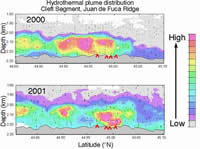| |

Hydrothermal plume distribution over the
northern
half of the Cleft segment in 2000 (top) and 2001 (bottom). Plume
intensity, in terms of particle concentration, indicated by the color
scale. Known vent sites show by inverted red Vs. |
|
R/V Wecoma - CTD Cruise
Science News
Science
Report - Friday, July 27, 2001
Position - 45 04.138' N /130 18.796' W
Chief Scientist Ed Baker
Even
flying over an ocean basin drained and dry you might not recognize the
largest volcano on the planet. Some volcanic features would be instantly
recognizable--the cone-shaped Hawaiian volcanoes rise from the Pacific
Ocean floor to thousands of meters above the level of our vanished sea
surface. But volcanoes that look like volcanoes account for only a small
fraction of the total amount of lava erupted each year from deep below
the earth's crust. The earth's mightiest founts of lava are the sinuous
midocean ridges that snake through every ocean basin. This "wound
that never heals," as the pioneering oceanographer Bruce Heezen called
it, is a linear volcano that marks where the earth's tectonic plates inexorably
separate at about the rate your fingernails grow.
While
midocean ridges have been recognized as volcanoes since the middle of
the last century, only in the last decade have oceanographers begun to
recognize what happens on the seafloor during an eruption.. While our
work at Axial Volcano has been directed at the most recent eruption detected,
the first studies of eruption events were made here on the Cleft segment
of the Juan de Fuca Ridge. By good fortune (and wise planning) a NOAA
Vents cruise was making hydrothermal measurements here in 1986 when scientists
observed a hydrothermal plume far more enormous than any previously observed.
Continued study demonstrated it was most likely the remnant of a seafloor
lava eruption that propelled a short-lived but superheated gusher of hydrothermal
fluid more than a kilometer above the seafloor.
Since
that discovery, the Vents Program and other researchers have visited this
area yearly to track the long term changes that are the legacy of the
1986 eruption. Unlike Axial, where we have seen clear differences each
year since the 1998 eruption, changes here 15 years removed from the lava
flow are subtle. The accompanying figure compares the distribution and
intensity of plumes along the northern half of the Cleft Segment last
year with that found this year. High plume intensities are found above
known vent sites in both years. Small changes in the plume distribution
are most likely caused by day-to-day variations in bottom currents that
mix and disperse the hydrothermal discharge from each vent site. Some
plumes are found far from the known vent sites; perhaps there are active
sites yet to be discovered. Most remarkably, however, hydrothermal activity
here remains robust and widespread fully 15 years after the last lava
eruption. Thus the heat source that drives hydrothermal circulation here
must be deeper and larger than that at Axial Volcano, where the plumes
have declined sharply just 3 years after the 1998 eruption.
|

